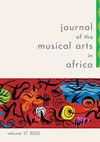Contemplating African art music: a reflection on the Akin Euba Symposium and Concert
IF 0.2
4区 艺术学
0 MUSIC
引用次数: 1
Abstract
One of the widely acknowledged features of African music is its organic and proximal connection to social and cultural life. Activities such as marriage ceremonies, funeral rites, the installation of kings and religious festivals depend significantly on musical performance in articulating the social and religious norms that hold a society together. As exemplified in the Yoruba dùndún performance, music in African communities is often an intensely social experience in which musical contemplation – which I define as the act of processing and engaging with music in terms of, and beyond, its formal and aesthetic principles – is socially grounded. The art of musical enjoyment – or the process of musical contemplation – is not limited to the processing of musical aesthetics. Quite often musical contemplation is complete only when there is an extra-musical context (social or religious, for example) within which one engages with the appeal of musical creativity and the dynamics of performance. If the Yoruba tradition is indicative, traditional African musicians often situate and conceive the aesthetic or entertaining elements of their performance (the aesthetic or congeneric space) within the specific context of that performance (the embodied space), and do so in ways that are referential to the values of the larger society (the social space).1 What they generate in the process is an integrative system of musical signification. The connections between aesthetic, embodied and social spaces provide an important background for understanding how modern African performances tend to depart from traditional practices. In a contemporary work for piano and Yoruba dùndún drums, for example, changes are apparent in the context of performance (concert hall), the musical sound (piano as well as the syntactical and aesthetic constructs marking its use), and the social significance (elitism, modernism and/or individuated contemplation). More significantly, however, the process of connecting these spaces in ways that facilitate an integrated system of contemplation is often unarticulated by the composer or unbeknownst to the listener. The degree to which such connections are forged and the mode of forging them would certainly思考非洲艺术音乐:对Akin Euba研讨会和音乐会的反思
非洲音乐被广泛认可的特征之一是它与社会和文化生活的有机和密切联系。婚礼、葬礼、国王登基和宗教节日等活动在很大程度上依赖于音乐表演来表达将社会团结在一起的社会和宗教规范。如约鲁巴dùndún表演所示,非洲社区的音乐通常是一种强烈的社会体验,其中音乐沉思——我将其定义为处理和参与音乐的行为,超越其形式和美学原则——是基于社会的。音乐欣赏的艺术——或音乐沉思的过程——并不局限于音乐美学的处理。通常情况下,只有在音乐之外的环境(例如社会或宗教)中,人们才能参与到音乐创造力的吸引力和表演的动态中,音乐沉思才算完整。如果约鲁巴传统是指示性的,传统非洲音乐家通常将其表演的美学或娱乐元素(美学或同质空间)置于表演的特定背景(具体化空间)中,并以与更大社会(社会空间)的价值观相关的方式进行他们在这个过程中产生的是一个音乐意义的综合系统。审美、体现和社会空间之间的联系为理解现代非洲表演如何偏离传统做法提供了重要的背景。例如,在钢琴和约鲁巴dùndún鼓的当代作品中,在表演(音乐厅),音乐声音(钢琴以及标志其使用的句法和美学结构)和社会意义(精英主义,现代主义和/或个性化沉思)的背景下,变化是明显的。然而,更重要的是,连接这些空间的过程,以促进一个完整的沉思系统,往往是作曲家或听众所不知道的。建立这种联系的程度和建立这种联系的方式肯定会
本文章由计算机程序翻译,如有差异,请以英文原文为准。
求助全文
约1分钟内获得全文
求助全文

 求助内容:
求助内容: 应助结果提醒方式:
应助结果提醒方式:


